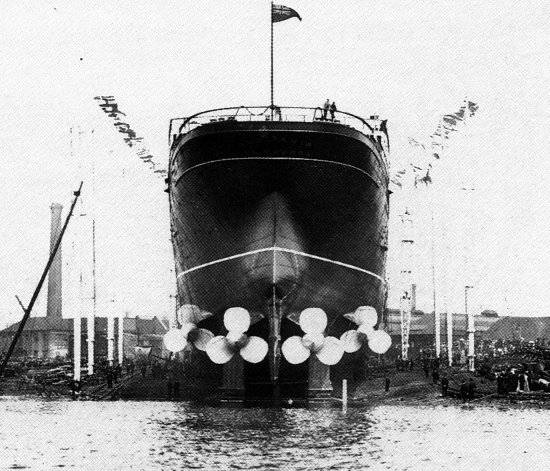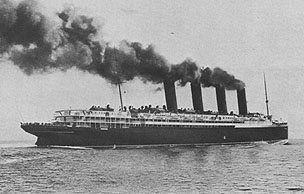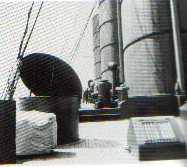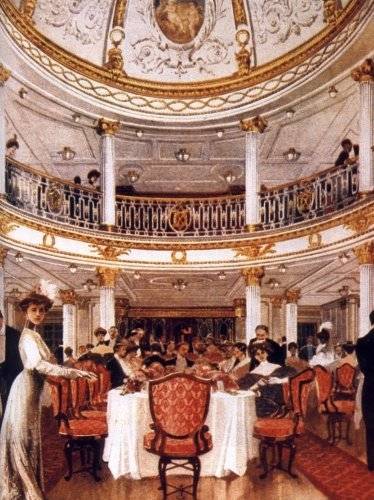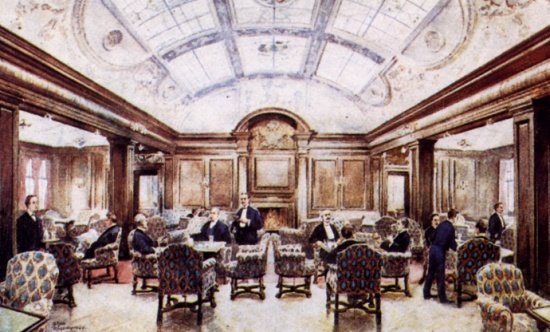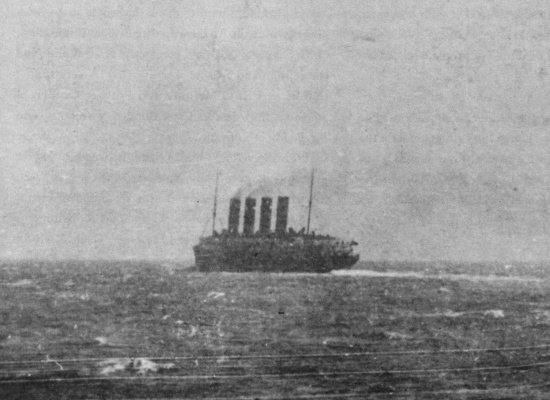At the beginning of the 20th Century, Germany had seemed to eclipse Britain in terms of ship building. To have a place which didn�t have any merchant ships at all suddenly get together and build four stackers was a tremendous blow to English shipping. Germany�s Kaiser Wilhelm der Grosse and Deutschland threateded Britain�s domenance of the trans-Atlantic trade. J P Morgan had recently bought the White Star Line too, and meant that although White Star ships still flew the Union Jack, they sailed for America. This concerned Lord Inverclyde, Chairman of the Cunard Line. He thought that because they were now American, the admiralty couldn�t use White Star�s ships in the event of war. Inverclyde then went to the British government with these concerns, and a plan�
Inverclde decided that to compete with the German liners, he would need to build ships that were bigger, faster, more luxurious and safer that the German ships. Inverclyde proposed that if the government financed the construction of two ships, they would be available as auxillary cruisers in the advent of war. The government agreed, and so Lusitania and Mauritania were born.
Leonard Peskett designed the two ships, and submitted the first plans in 1902. Tthey depicted liners with only three funnels, but a fourth was added to compete with the German�s four stackers. Displacing 31,550 gross tons, Lusitania was built by John Brown Shipyards at Clydebank in Scotland. Her dimensions were far bigger than any other ship built before. She was 785 feet long and 88 feet wide at her widest point. Her hull was divided into 34 major watertight compartments, 17 on each side, seperated by a huge bulkhead down the middle. It was this middle bulkhead that would help doom Lusitania. Four million rivets, weighing more than 500 tons, held her massive hull plates together and nearly 300 miles of cabling was laid throughout her interior to supply electricity to her novel conveniences; elevators, electric fans, clocks and lamps.
While Lusitania grew in the John Brown Shipyards, in England on the side of the Tyne, Mauritania mirrored her progress. One can imagine the ideas each company comes up with to make their ship bigger, better or faster. Mauritania was the larger of the two, and was more rounded off at the bow and bridge. She also had four bladed propellers compared to Lusitania�s three, making her faster that her sister. One easy way to tell the siters apart was that Mauritania had the traditional ventilators on the top more deck. Lusitania was hinge topped ones, and while they made the deck seem less cluttered, they needed contrant replacing. The two sisters were designed to win Cunard back the Blue Ribband. Lord Inverclyde however would never see his two ships together, or even on water. He died suddenly at the age of 44 in 1905, leaving his widow Lady Mary Inverclyde to launch the ships.
After her launch, Lusitania was towed to her fitting out basin where she would be transferred from an empty hulk into a huge powerplant and one of the most luxurious ships in the world. During her trials on July 27th, 1907 however, it was found that her stern viabrated so dramatically because of the turbines, that many second class cabins would be uninhabitable. She was taken back into dry dock, and her entire stern was gutted and brackets, arches and columns, anything that would support the ship was added. Although it helped, a shuddering stern would plauge Lusy for her entire career. On September 3rd, she was opened to the public and on the 7th, she departs Liverpool for her maiden voyage. While it didn�t prove to be a record breaker, it was a great success. The Blue Ribband was back in Britain�s grasp. In the following month, she suceeds in capturing the Blue Ribband, holding it until her sister Mauritania took it from her in 1910.
Lusitania and Mauritania were known as �wet ships� because of the shape of the bow. When it plunged into a tall swell, water would pound over the forcastle deck. During one encounter with a huge wave in January 1910 off the Grand Banks, a massive swell pushed the bridge aft by several inches.
Everyone who came aboard Lusitania was charmed by her elegance. Unlike her White Star rivals who use the same interior design for all ships of a certain class, Cunard instead got different designers to create the interiors of each ship. Instead of the darker harder textures of the Mauritania, Lusitania had a lighter, airier feel to her. While Mauritania had the Blue Ribband and was undoubtably the faster of the two, Lusitania proved to be the more popular because of her interiors.
When the Titanic sank, Lusitania was undergoing routine maintenance. Before she was put back into service, she was fitted with more lifeboats and lifebouys. Mauritania was recalled when she came back to England to be fitted with more as well.
Only a few weeks before the outbreak of World War One, the Cunard duo had been turned into a trio. Aquitania only made two voyages before armageddon. When the original two liners were designed, they had a second set of plans, one for war. However, instead of the older Lusitania, the admiralty called up Aquitania, possibly saving the newest ship from a very unfortunate death. Mauritania and Aquitania went away and were transferred into war ships, while Lusitania remained a civillian ship. It was thought she could safely outrun a German U-Boat submarine. Still, for safety�s sake she was given black funnels and a yellow band along one of her decks, obscuring her identity as a Cunarder. It is unclear if she carried this livery on her last voyage, as Cunard said in a news report that they were satisfied she was safe from enemy attack because of her civillian work, however, what appears to be footage of her leaving New York on her last voyage clearly shows her carrying these colours.
Lusitania was set to depart New York on May 1st, 1915 under the command of Captain William Turner. 59 year old turner had been at sea since he was 13, and was a man of the ocean. Turner was confident that he could out run any U-Boat, and was sure that if a danger presented itself, an escourt would be at Lusy�s side.
Before her departure from neutral America, in the New York Times among the various advertisments for liners, next to Lusitania�s ad, a notice appeared.
�Travellers intending to embark on the Atlantic voyage are reminded that a state of war exists between Germany and her allies and Great Britain and her allies; that the zone of war includes the waters adjacent to the British Isles; that in accordance with formal notice given by the Impirial German Government, vessels flying the flag of Great Britain, or any of her allies, are liable to destruction in those waters and that travellers sailing in the war zone on ships of Great Britain or her allies do so at their own risk. Imperial German Embassy.
The notice didn�t seem to deterre many people though, and 1959 people boarded Lusitania from Cunard�s Pier 54. There were only 12 cancelations.
|




